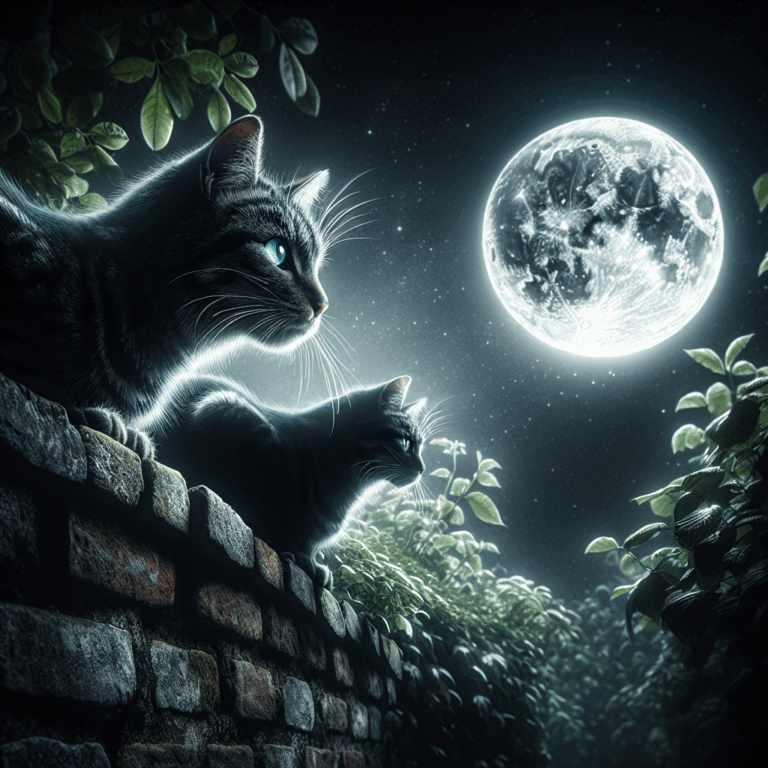The Nocturnal Navigators: How Cats Conquer the Night
Cats have long intrigued humans with their mysterious nocturnal behaviors, prowling silently through the night as if guided by some unerring internal compass. While we often associate them with a leisurely life of sunbathing and napping, cats are, by nature, crepuscular creatures, most active during the twilight hours. This lifestyle adaptation is rooted deeply in their history as both predators and prey, and it has endowed them with a suite of remarkable abilities tailored for nighttime exploration.
One of the most fascinating aspects of feline nocturnal activity is their superb night vision. Unlike humans, cats possess a higher number of rod cells in their retinas, which are responsible for detecting light and motion. This adaptation allows them to see with remarkable clarity in low-light conditions, an essential trait for hunting in the dimness of dusk and dawn. Furthermore, their eyes are equipped with a layer of tissue called the tapetum lucidum, which reflects light that passes through the retina back into the eye, enhancing their ability to see in the dark.
But it’s not just their eyes that make them adept night navigators. Cats also rely heavily on their acute sense of hearing. Their ears can pivot independently, allowing them to pinpoint the faintest rustle of a mouse or the flutter of a moth. Coupled with their silent, padded paws, cats can stalk their prey with stealth and precision, often without making a sound. This silent pursuit is a testament to their evolutionary history, where the ability to approach prey unnoticed was a crucial survival skill.
The feline sense of smell also plays a significant role in their nocturnal activities. Cats possess a highly developed olfactory system, with a sense of smell that is approximately fourteen times stronger than that of humans. This sharp olfactory ability is not only vital for tracking prey but also for marking territory and identifying other cats in the area. It’s a complex communication system that operates silently as they navigate the night.
Moreover, the social dynamics of cats during the night are a topic that continues to fascinate scientists. While domestic cats may live solitary lives, their wild ancestors were known to form loose social groups, particularly when resources were plentiful. This behavior is occasionally observed in feral cats, who may band together to share hunting grounds or protect each other from larger predators. These nocturnal gatherings are often accompanied by a series of vocalizations, from the gentle trill of a mother calling her kittens to the more assertive growls and hisses of territorial disputes.
In urban environments, the nocturnal habits of cats have adapted in interesting ways. Street lights and the bustle of city life mean that even the darkest hours are illuminated by artificial light, yet cats continue to thrive, their instincts guiding them through a landscape that has changed dramatically from the natural habitats of their ancestors. This adaptability is a testament to their resilience and intelligence, characteristics that have made them beloved companions to humans across cultures and centuries.
As we peer into the enigmatic world of the cat’s nightlife, we gain a deeper appreciation for these fascinating creatures. Their ability to move with grace and precision, to see in the dimmest of light, and to communicate in ways that remain largely hidden to us, speaks to their incredible evolutionary journey. Understanding the night from a cat’s perspective not only enriches our knowledge of these remarkable animals but also enhances the bond we share with our feline friends, who, even when curled up comfortably at the foot of our beds, are the descendants of master nocturnal navigators.

Cats have long intrigued humans with their mysterious nocturnal behaviors, prowling silently through the night as if guided by some unerring internal compass. While we often associate them with a leisurely life of sunbathing and napping, cats are, by nature, crepuscular creatures, most active during the twilight hours. This lifestyle adaptation is rooted deeply in their history as both predators and prey, and it has endowed them with a suite of remarkable abilities tailored for nighttime exploration.
One of the most fascinating aspects of feline nocturnal activity is their superb night vision. Unlike humans, cats possess a higher number of rod cells in their retinas, which are responsible for detecting light and motion. This adaptation allows them to see with remarkable clarity in low-light conditions, an essential trait for hunting in the dimness of dusk and dawn. Furthermore, their eyes are equipped with a layer of tissue called the tapetum lucidum, which reflects light that passes through the retina back into the eye, enhancing their ability to see in the dark.
But it’s not just their eyes that make them adept night navigators. Cats also rely heavily on their acute sense of hearing. Their ears can pivot independently, allowing them to pinpoint the faintest rustle of a mouse or the flutter of a moth. Coupled with their silent, padded paws, cats can stalk their prey with stealth and precision, often without making a sound. This silent pursuit is a testament to their evolutionary history, where the ability to approach prey unnoticed was a crucial survival skill.
The feline sense of smell also plays a significant role in their nocturnal activities. Cats possess a highly developed olfactory system, with a sense of smell that is approximately fourteen times stronger than that of humans. This sharp olfactory ability is not only vital for tracking prey but also for marking territory and identifying other cats in the area. It’s a complex communication system that operates silently as they navigate the night.
Moreover, the social dynamics of cats during the night are a topic that continues to fascinate scientists. While domestic cats may live solitary lives, their wild ancestors were known to form loose social groups, particularly when resources were plentiful. This behavior is occasionally observed in feral cats, who may band together to share hunting grounds or protect each other from larger predators. These nocturnal gatherings are often accompanied by a series of vocalizations, from the gentle trill of a mother calling her kittens to the more assertive growls and hisses of territorial disputes.
In urban environments, the nocturnal habits of cats have adapted in interesting ways. Street lights and the bustle of city life mean that even the darkest hours are illuminated by artificial light, yet cats continue to thrive, their instincts guiding them through a landscape that has changed dramatically from the natural habitats of their ancestors. This adaptability is a testament to their resilience and intelligence, characteristics that have made them beloved companions to humans across cultures and centuries.
As we peer into the enigmatic world of the cat’s nightlife, we gain a deeper appreciation for these fascinating creatures. Their ability to move with grace and precision, to see in the dimmest of light, and to communicate in ways that remain largely hidden to us, speaks to their incredible evolutionary journey. Understanding the night from a cat’s perspective not only enriches our knowledge of these remarkable animals but also enhances the bond we share with our feline friends, who, even when curled up comfortably at the foot of our beds, are the descendants of master nocturnal navigators.



19 thoughts on “The Nocturnal Navigators: How Cats Conquer the Night”
This article provides fascinating insights into the abilities and behaviors cats exhibit during their nighttime activities.
The article does offer interesting points, but it lacks depth on how these nocturnal abilities specifically impact domestic cats in urban settings. More detailed studies or data would strengthen the insights provided.
Fascinating insights into how these remarkable creatures use their unique abilities to thrive after dark!
What a fascinating insight into the amazing abilities of cats and their nighttime adventures!
This insightful post beautifully highlights the remarkable adaptations that make cats such skilled nighttime explorers.
Indeed, the article does a great job of showcasing the fascinating abilities cats have for nighttime adventures. Their adaptations are truly impressive!
This post offers fascinating insights into the remarkable abilities of cats during their nighttime adventures.
This article beautifully highlights the fascinating abilities and adaptability of our feline companions during their nighttime adventures!
The post provides an insightful look into feline nocturnal behavior, but it overlooks the impact of urban environments on wild cat populations.
This post beautifully highlights the fascinating abilities that enable cats to thrive during night hours.
This post beautifully highlights the fascinating adaptations that make cats such skilled night explorers.
This post provides an insightful look into the fascinating abilities and behaviors of cats during nighttime.
This insightful post beautifully highlights the remarkable adaptations that enable cats to thrive during their nocturnal adventures.
What a fascinating look into the incredible skills and instincts that allow cats to thrive during their nighttime adventures!
It’s intriguing how the post highlights cats’ evolutionary traits, yet it glosses over the challenges they face in urban environments.
This insightful post beautifully highlights the remarkable adaptations and abilities that make cats such fascinating creatures of the night.
I’m glad you enjoyed the article! Cats truly have some incredible adaptations that allow them to thrive in low-light conditions. Their night-time skills are fascinating!
Fascinating insights into the remarkable abilities and adaptations of cats during their nighttime adventures!
This post provides an insightful look into the remarkable adaptations and behaviors that enable cats to thrive during nighttime hours.
Comments are closed.